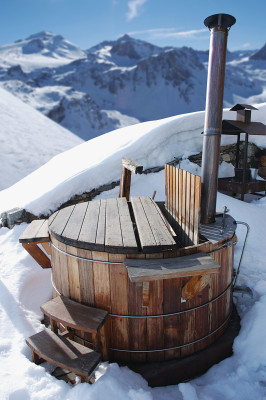| HOT SPRINGS: THE FIRST NATURAL HOT TUBS |
|---|
| While there are many geothermal springs in the U.K., some of the most famous can be found in the county of Bath in article text southwest England. Bath owes its name and its history to the hot mineral waters that rise at the King’s Spring and a few others nearby. These spas are the only true ‘hot’ springs that naturally occur in the U.K. (as defined by having temperatures higher than 37 C [98.6 F]). They include: ● Cross Bath 42.8 C (109 F); ● Stall Street Fountain 45.4 C (113.7 F); ● Hetling Spring 45.4 C (113.7 F); ● King’s Bath 45.6 C (114 F); and ● Hot Bath 47.2 C (117 F).Bath was not the only location with therapeutic hot springs; many other cultures around the world believed bathing in a particular spring, well or river resulted in physical and spiritual purification. Different forms of this practice have existed and are well documented among Native Americans, Persians, Babylonians, Egyptians, Greeks and Romans. There is substantial evidence suggesting and supporting the ancient belief in the healing and purifying properties of both hot and cold water. These naturally occurring springs that ‘healed with water’ contained many types of therapeutic mineral water. The dissolved substances in the water may include various salts and sulphur compounds. Mineral water can be sparkling (with effervescence) or still (without effervescence). While every spring is slightly different, most are rich in sodium (Na), sulphur (S), calcium (Ca), silica (SiO2), selenium (Se) and radium (Ra). Their benefits include muscle relaxation, skin exfoliation, toxin removal and increased blood circulation.There are two primary classifications of hot springs:Filtration hot springs These springs comprise geothermally heated mineral water that is initially fed by rainwater, which seeps into the Earth. As it travels, the water is subjected to increased energy through natural geothermal heat and is exposed to gases and often a wide variety of minerals from rock and mineral deposits. The water adsorbs the minerals via leaching, is heated by the geothermal source and then returns to the Earth’s surface.Primary hot springs These springs comprise geothermally heated mineral water where direct volcanic activity plays a far greater role in the spring formation process. One of the fundamental physical distinctions between a filtration and primary spring is the water’s mineral and gas content. Primary springs are often powered by magma chambers, which exist under the Earth’s surface, as well as in volcanically active regions. |
The strive for portability
Modern cement and plaster hot tubs are probably the most common image when the word comes to mind. These hot tubs are usually part of the overall pool design and have a bench-style seat with therapeutic jets mounted in the plaster. The water is typically heated with a natural gas heater and the jets use both water and air (from a blower) to provide hydrotherapy. However, it goes without saying, this hot tub style is not considered portable.

While early pool builders were designing plaster hot tubs for customers, the first portable hot tubs were also being designed and modelled after wooden soaking tubs using old oak barrels, wine tanks and olive vats. These hot tubs started to appear in the ‘40s and were inspired by the previously mentioned Japanese ofuro.
Soon after this, wooden-staved soaking tubs came to market. They were built of redwood, cedar or teak and held together by steel bands. They ranged in depth—from 1 to 1.2 m (3 to 4 ft)—and usually included a wooden bench for seating along the hot tub’s inner circumference. Hot water soaking was the primary therapeutic purpose of these early designs.
While early wooden tubs lacked jets and bubbles, not to mention water management systems, their popularity increased with many users in the early ‘60s. Early designs, however, were prone to leak and keeping the water clean was a constant chore. Soon, however, a new element was introduced, which would change the face of hot tubs.
The bubble breakthrough
Most spa industry veterans know the Jacuzzi brothers’ story. While the name is synonymous with hot tubs, the company, comprising seven brothers who emigrated to the U.S. from Italy in the 1900s, was originally involved in the aviation industry before making a breakthrough in the hot tub sector.
In the mid-1920s, the family developed a deep-well pump, which revolutionized the agriculture industry. Thirty years later, a submersible aerating pump was invented and became the first portable hydrotherapy pump. This was the key component that would jumpstart the entire hot tub industry.
The pump’s swirling air-and-water mixture proved highly therapeutic and could turn virtually any vessel of water into a mini-spa. Sensing the consumer’s interest in health, fitness and leisure activities, in 1968 the company developed and marketed the first self-contained, fully integrated whirlpool bath.
With the new pump and jet combination, the jetted bath and hot tub were born and soon developed into the hot tub as it is known today. This new concept quickly gained acceptance from consumers and added momentum to this newly emerging product category.
The late 1960s also saw the emergence of some of the first viable fibreglass hot tub moulds, which used a gel-coat finish to make the surface less porous. Not only did these hot tubs cost less than their plaster counterparts, the fibreglass material allowed a more uniform production and they could be mass-produced in moulds.
Fibreglass hot tub designs also offered several advantages over units made of wood or plaster, such as increased seating comfort and greater consistency in the unit’s hydraulics. Even with these advantages, fibreglass hot tubs were still not the final solution to truly achieving a self-contained hot tub.






